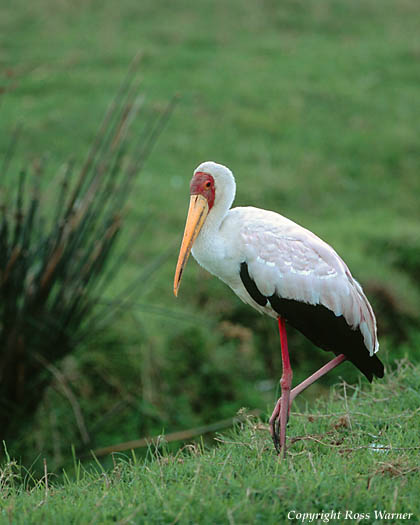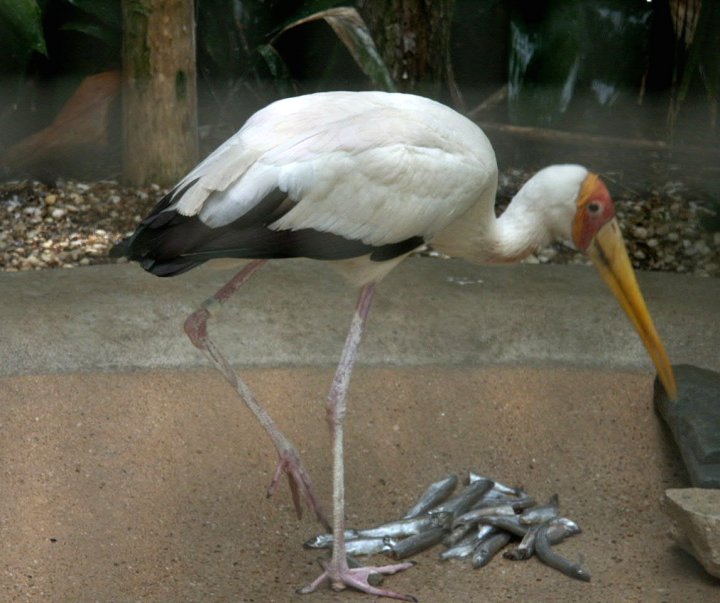Yellow-Billed Stork in breeding colors.
It is interesting that during the breeding season these storks display feathers with a tinge of the same pink color that can be seen in their relatives, the Roseate Spoonbills.
Adult male yellow-billed storks have a smooth forehead and their face is orangey-red. Their bills are long and thick at the base. It is also slightly curved at the tip and bright yellow, hence their name. Their necks are also long and slender and grayish white. The rest of their body including their back, belly and breast is solid white with a small hint of pink on the tips of their feathers. Their tail and wing quills are black The yellow-billed storks legs vary from a dark red to a light pink color and are long and skinny. Its hard to believe that their legs can support their plump, round bodies. The female storks are alot like the male storks, however the females are smaller.
The yellow-billed storks do not flock in large social groups. These storks do not socialize much with one another either. These wading birds like to isolate themselves in swamps, muddy rivers and other large areas of shallow, marshy waters. These birds move around slowly and deliberately. The yellow-billed storks are extremely inactive, they rest and feed for most of the day.
The yellow-billed storks have remarkable adaptation. These birds are know to have the quickest muscular reflex of the neck, allowing almost all food to be caught in the water. Their long, narrow, curve tipped bills allow them only to catch small prey such as small fish, frogs, insects and worms passing by in the water. Yellow-billed storks are intelligent birds. These birds created a technique to help them catch more prey in the water. They typically use one foot to stir up the water or mud which disturbs and flushes out the prey. Then they submerge their heads quickly in the water snapping their bills on small prey. Yellow-billed storks bills are great fishing tools.
The female yellow-billed storks approaches the courtship among the male yellow-billed storks. Together they build a bulky nest made of sticks and the male chooses where the nest is to be built. The two storks work vigorously together to build a nest and can do so within 7-10 days. These nests are usually built high in trees away from predators. The storks breed almost year round. At breeding colonies the storks make a hissing sound. Incubation period can last up to 30 days and between 2-3 eggs are laid on alternate days.
The yellow-billed storks are a new addition to the Fort Worth Zoo. These birds were shipped to the Fort Worth Zoo from MetroZoo in Miami after they hatched. These birds were saved from the Hurricane that destroyed the Zoo in 1992. The parents were unfortunately lost in the storm. These birds are rather slow moving and quiet and feed for most of the day. I noticed that their bills make a hollow sound when closed quickly. Their cage is completely covered with a tarp except for a small viewing area. This helps keep the environment warm for the yellow-billed storks.

Shannon Listebarger
listeb75@hotmail.com
Sources
and Links:
Grzimeck's Animal Life Encyclopedia. Bernhard Grzimek, editor-in-chief.
New York, Van Nostrand Reinhold Co., 1975. Vol.7. Page 223.
The Pictorial Encyclopedia of Birds by J. Hanzak; edited by Bruce Campbell. London, Hamlyn, 1967. Page 81.
The Pictorial Encyclopedia of the Animal Kingdom by V.J.Stanek; edited by Peter L. Ames. London, Hamlyn, 1963. Page 360.
Oregon Zoo Animals: Yellow-Billed Stork
Picture was taken in Ngorongoro Crater in Tanzania
